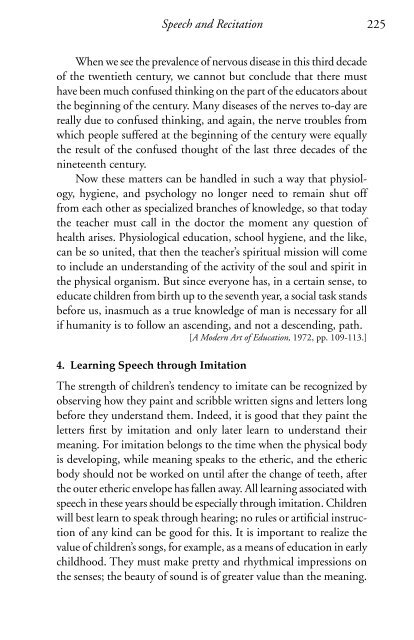Teaching Language arTs in The WaLdorf schooL
Teaching Language arTs in The WaLdorf schooL
Teaching Language arTs in The WaLdorf schooL
You also want an ePaper? Increase the reach of your titles
YUMPU automatically turns print PDFs into web optimized ePapers that Google loves.
Speech and Recitation<br />
225<br />
When we see the prevalence of nervous disease <strong>in</strong> this third decade<br />
of the twentieth century, we cannot but conclude that there must<br />
have been much confused th<strong>in</strong>k<strong>in</strong>g on the part of the educators about<br />
the beg<strong>in</strong>n<strong>in</strong>g of the century. Many diseases of the nerves to‐day are<br />
really due to confused th<strong>in</strong>k<strong>in</strong>g, and aga<strong>in</strong>, the nerve troubles from<br />
which people suffered at the beg<strong>in</strong>n<strong>in</strong>g of the century were equally<br />
the result of the confused thought of the last three decades of the<br />
n<strong>in</strong>eteenth century.<br />
Now these matters can be handled <strong>in</strong> such a way that physiology,<br />
hygiene, and psychology no longer need to rema<strong>in</strong> shut off<br />
from each other as specialized branches of knowledge, so that today<br />
the teacher must call <strong>in</strong> the doctor the moment any question of<br />
health arises. Physiological education, school hygiene, and the like,<br />
can be so united, that then the teacher’s spiritual mission will come<br />
to <strong>in</strong>clude an understand<strong>in</strong>g of the activity of the soul and spirit <strong>in</strong><br />
the physical organism. But s<strong>in</strong>ce everyone has, <strong>in</strong> a certa<strong>in</strong> sense, to<br />
educate children from birth up to the seventh year, a social task stands<br />
before us, <strong>in</strong>asmuch as a true knowledge of man is necessary for all<br />
if humanity is to follow an ascend<strong>in</strong>g, and not a descend<strong>in</strong>g, path.<br />
[A Modern Art of Education, 1972, pp. 109-113.]<br />
4. Learn<strong>in</strong>g Speech through Imitation<br />
<strong>The</strong> strength of children’s tendency to imitate can be recognized by<br />
observ<strong>in</strong>g how they pa<strong>in</strong>t and scribble written signs and letters long<br />
before they understand them. Indeed, it is good that they pa<strong>in</strong>t the<br />
letters first by imitation and only later learn to understand their<br />
mean<strong>in</strong>g. For imitation belongs to the time when the physical body<br />
is develop<strong>in</strong>g, while mean<strong>in</strong>g speaks to the etheric, and the etheric<br />
body should not be worked on until after the change of teeth, after<br />
the outer etheric envelope has fallen away. All learn<strong>in</strong>g associated with<br />
speech <strong>in</strong> these years should be especially through imitation. Children<br />
will best learn to speak through hear<strong>in</strong>g; no rules or artificial <strong>in</strong>struction<br />
of any k<strong>in</strong>d can be good for this. It is important to realize the<br />
value of children’s songs, for example, as a means of education <strong>in</strong> early<br />
childhood. <strong>The</strong>y must make pretty and rhythmical impressions on<br />
the senses; the beauty of sound is of greater value than the mean<strong>in</strong>g.

















